Fastening is a process of joining two or more machine elements together to work in a function. There will be two types of fastening. Permanent fastening such as welding, riveting and temporary fastening such as screwed joint. Screws are the temporary fasteners. which means the joining of the machine elements can be disassembled whenever it is required without damage to the machine or the fastening with the help of screwed joints. Let us discuss different Types of Screw Fasteners available in machine design.
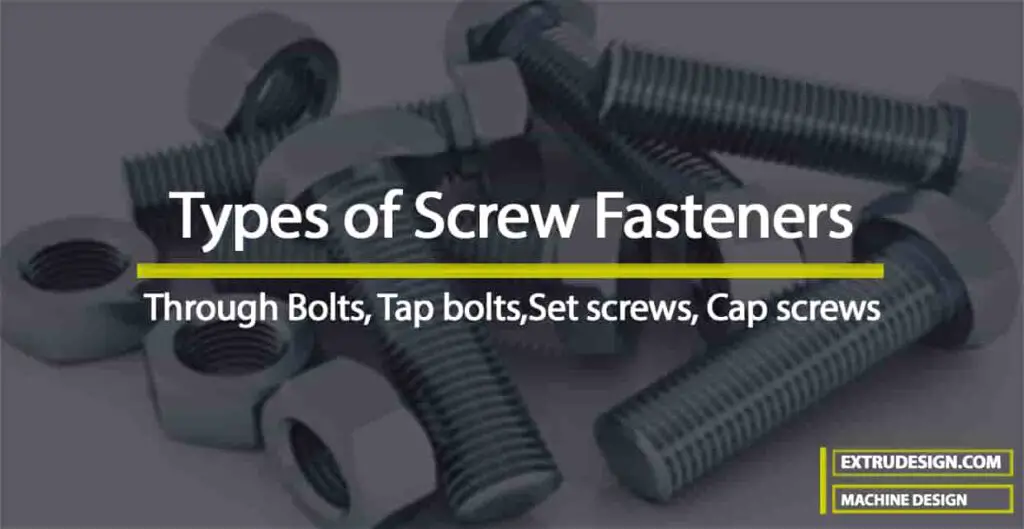
Screw Fasteners
Screw fasteners or Screwed joints are formed by a screw which is having a screw thread on its cylindrical surface. The screw thread is formed by cutting a continuous helical groove on a cylindrical surface.
- A screw made by cutting a single helical groove on the cylinder is known as single threaded or single-start screw.
- If a second thread is cut in the space between the grooves of the first, a double threaded or double-start screw is formed.
- Similarly, triple and quadruple and even multiple-start threads may be formed.
- The helical grooves may be cut either right hand direction known as right hand threads or can be cut in left hand direction known as left hand threads.
- The screwed joint is mainly composed of two elements one is the bolt and the other one is the nut.
- The screwed joints are widely used where the machine parts are required to be readily connected or disconnected without damage to the machine or the fastening.
- This may be for the purpose of holding or adjustment in assembly or service inspection, repair, or replacement or it may be for manufacturing or assembly reasons.
Types of Screw Fasteners
There are over 6 different Types of Screw Fasteners available for a Screwed joint.
- Through Bolts
- Tap Bolts
- Studs
- Cap Screws
- Machine Screws
- Set Screws
1. Through Bolts
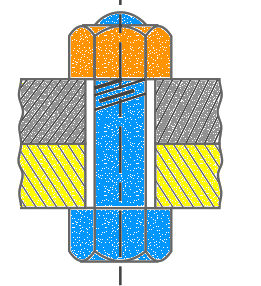
- A through bolt or also known as simply a bolt is shown in above figure.
- It is a cylindrical bar with threads for the nut at one end and head at the other end.
- The cylindrical part of the bolt is known as shank.
- It is passed through drilled holes in the two machine parts to be fastened together and clamped securely to each other as the nut is screwed on to the threaded end.
- The through bolts may or may not have a machined finish and are made with either hexagonal or square heads.
- A through bolt should pass easily in the holes, when put under tension by a load along its axis.
- If the load acts perpendicular to the axis, tending to slide one of the connected parts along the other end thus subjecting it to shear, the holes should be reamed so that the bolt shank fits snugly there in.
- The through bolts according to their usage may be known as machine bolts, carriage bolts, automobile bolts, eye bolts etc.
2. Tap Bolts
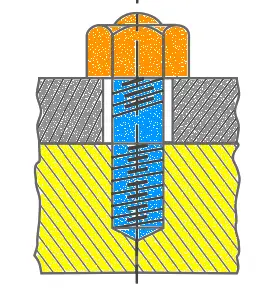
- Tap bolt is slightly different from the above Bolt, there will be no bolt head for the tap bolts.
- Instead of the through hole in the one machine part, a tapped hole will be required to screw the one end of the tap bolt into the machine part.
- The other end of the tap bolt will be joined by the nut as shown in above figure.
3. Stud
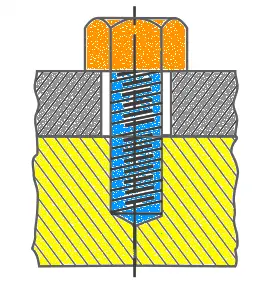
- A stud is a round bar threaded at both ends.
- One end of the stud is screwed into a tapped hole of the parts to be fastened, while the other end receives a nut on it, as shown in above figure.
- Studs are chiefly used instead of tap bolts for securing various kinds of covers e.g. covers of engine and pump cylinders, valves, chests etc.
- The disadvantage of the Tap bolts is that when tap bolts are unscrewed or replaced, they have a tendency to break the threads in the hole. This can be overcome by the use of studs.
4. Cap Screws
The cap screws are similar to tap bolts except that they are of small size and a variety of shapes of heads are available as shown in the below figure.
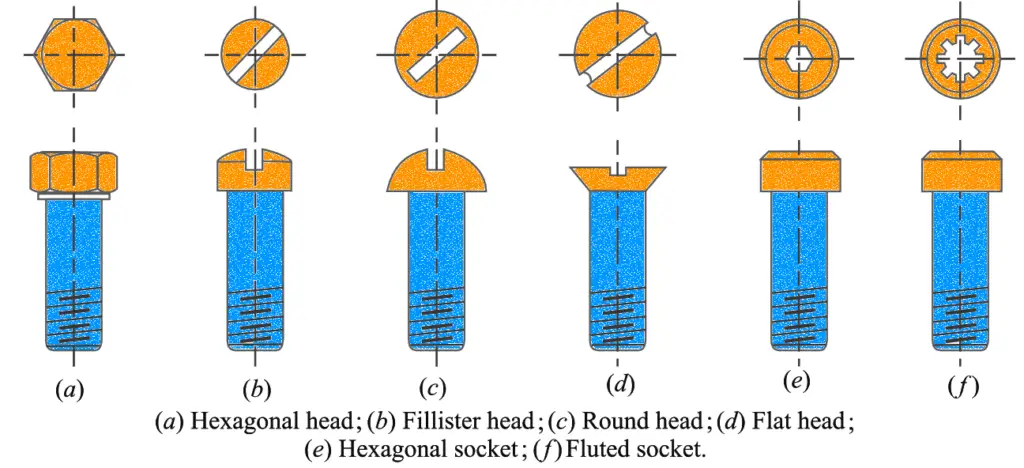
5. Machine screws.
These are similar to cap screws with the head slotted for a screwdriver. These are generally used with a nut.
6. Set Screws
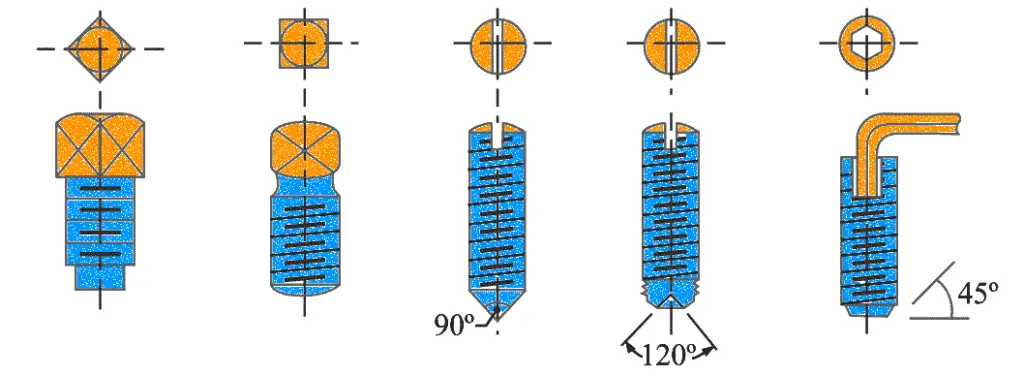
- The set screws are shown in the above Figure, these are used to prevent relative motion between the two parts.
- A set screw is screwed through a threaded hole in one part so that the end of the screw presses against the other part.
- This resists the relative motion between the two parts by use of friction between the point of the screw and one of the parts.
- They may be used instead of a key to preventing relative motion between a hub and a shaft in light power transmission members.
- They may also be used in connection with a key, where they prevent relative axial motion of the shaft, key and hub assembly.
How to calculate set screw size and how much torque can be transferred with a set screw on a shaft and hub?
The diameter of the set screw (d) may be obtained from the following expression is
d = 0.125D + 8mm
∴ where D is the diameter of the shaft (in mm) on which the set screw is pressed.
The tangential force (in newtons) at the surface of the shaft is given by F = 6.6 (d )2.3
∴ Torque transmitted by a set screw T = F × (D/2) N-m
∴ Power transmitted (in watts), P = (2π×N×T) / 60
where N is the shaft speed in RPM.
Here you can calculate torque from power!
Advantages of Screwed Joints
- Screwed joints are highly reliable in operation.
- Assembly and disassembly of the machine elements are more convenient with Screwed joints.
- A wide range of screwed joints may be adapted to various operating conditions.
- Screws are relatively cheap to produce due to standardisation and highly efficient manufacturing processes.
Disadvantages of Screwed Joints
The main disadvantage of the screwed joints is the stress concentration in the threaded portions which are vulnerable points under variable load conditions. And also the strength is comparatively very less than riveted joints and welded joints.
Conclusion
These are the different Types of Screw Fasteners available as of the global standards. But most of the screw fasteners are produced in-house based on the function requirement of the products. They may vary from the above-mentioned types of screw Fasteners. Let us know what kind of screw fasteners you have seen.

Leave a Reply